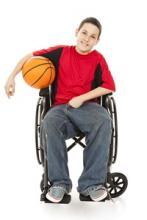
The UN Convention on the Rights of the Child states in Article 31: “Children have the right to relax and play, and to join in a wide range of cultural, artistic and other recreational activities.” The right to play applies to all children regardless of their race, religion, or abilities.1
Inclusive play for children primarily allows equal access and participation in play opportunities. But it is more than just inclusion. High quality play opportunities for children regardless of their abilities is the aim for inclusive play. Although all children might not be able to participate in all play activities, a variety of play activities should be available for them to choose that are interactive with others.2
The playground is a natural play environment where children have the opportunity to learn to take risks, negotiate, and overcome obstacles. It is a place where children develop friendships and a sense of belonging to a peer group. However, children with disabilities often do not have the same access to play equipment and are not given the opportunity for inclusive play with others. Lady Allen of Hurtwood stated: “It is difficult for children to grow up emotionally stable if they are denied space and freedom to take and overcome risks, and if they are denied the opportunity to make friends with others of their own age.”3
When applying principles of universal design for children’s playgrounds, the purpose is to provide “inclusive play where every child, regardless of ability or disability, is welcomed and benefits physically, developmentally, emotionally and socially from the environment.” This allows all children the opportunity to achieve the benefits that play has to offer.4
Many factors are considered when designing playgrounds for inclusive play. Uniform surfacing, ramps, and transfer decks can aid in providing better access and navigation around the playground. To improve motor skills, swings can be included with extra back and arm support for those who need it, climbers can offer better footholds, and horizontal bars can be placed at varying levels to allow children in wheelchairs to pull themselves up. Activities that encourage interaction with others can also be included, such as double slides, talk tubes, and imaginary themed play pieces.5
Inclusive playgrounds are often designed with elements that give sensory feedback that can help those with hearing and visual impairments as well as those with a sensory processing disorder. Audio stimulation can come from chimes throughout the playground to help those with visual impairments recognize where they are and navigate the playground. Cubby holes can be placed strategically to allow children with autism to have a quiet place to feel safe when over stimulated by the playground as well as allowing a group of children to socialize or engage in pretend play together.6
When including more ground-level equipment in the playground design, children of all abilities have greater access to activities that challenge and feature motion thus developing their senses, such as vestibular coordination, which contributes to balance and proprioception. Ground-level equipment also allows for more social interaction with other children, while engaged in mutual activities designed for all children to use. Manipulative play panels that include musical elements or games like Tic-Tac-Toe can be enjoyed by all children.7
Barriers to inclusive play are often more than just physical shortcomings of the playground design. Children are more likely to be excluded from play opportunities from children’s attitudes, fears, and misunderstandings of those with disabilities. Play providers can overcome these barriers for children with positive, deliberate actions to include all children in play activities.8
- 1. “FACT SHEET: A summary of the rights under the Convention on the Rights of the Child.” UNICEF. < http://www.unicef.org/crc/files/Rights_overview.pdf > 8 July 2011.
- 2. Scott, Rachel. “Factsheet No. 8 Inclusive Play.” National Children’s Bureau. Children’s Play Information Service. < http://www.ncb.org.uk/cpis/cpis_factsheet8_inclusiveplay_20090824.pdf > 7 July 2011.
- 3. Ibid.
- 4. Skulski, Jennifer K. “Designing for Inclusive Play: Applying the Principles of Universal Design to the Playground.” National Center on Accessibility. < http://www.ncaonline.org/?q=node/331 > 7 July 2011.
- 5. “Ideas for the design of your accessible playground from Unlimited Play.” Accessible Playgrounds.< http://www.accessibleplayground.net/?p=2058 > 7 July 2011.
- 6. Op. cit., Skulski.
- 7. Kaplan, Mara and Ian Proud. “Play for All – Thinking Outside the Ramp.” Accessible Playgrounds. < http://www.accessibleplayground.net/?p=2079 > 7 July 2011.
- 8. Op. cit., Scott.

